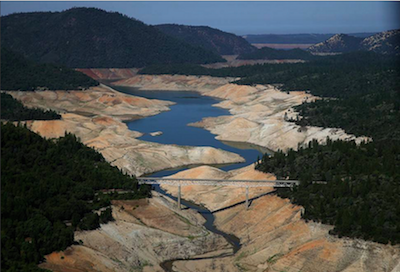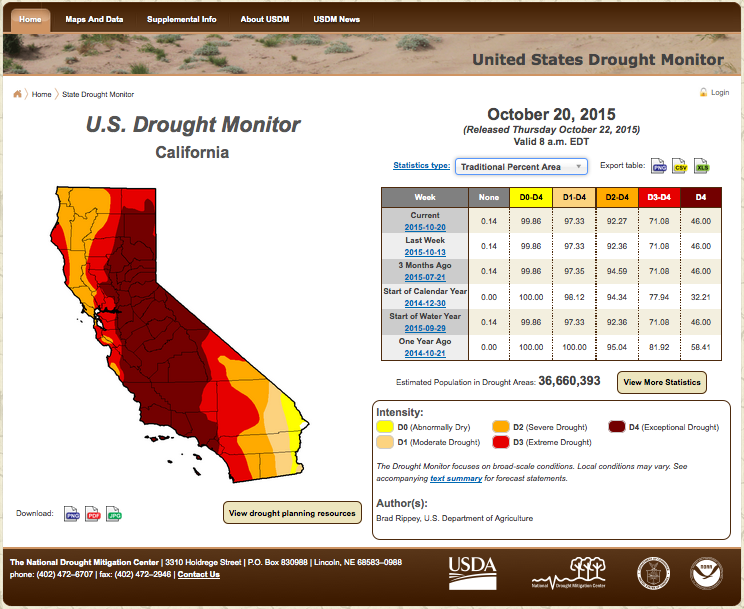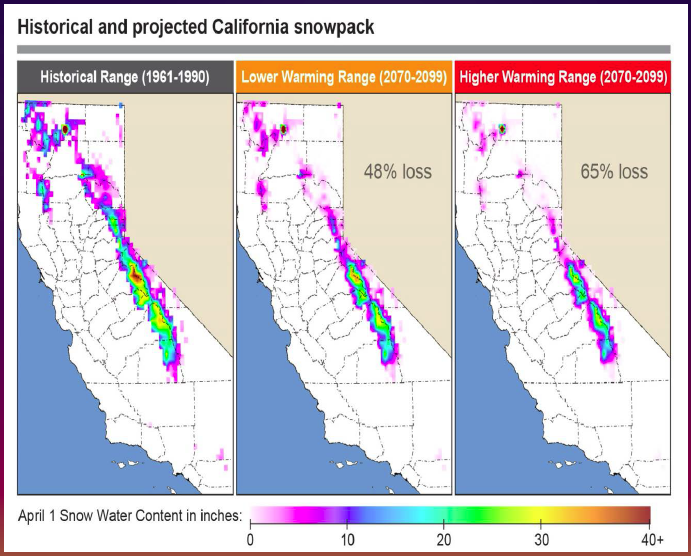Drought and Climate Change
 Lake Oroville in 2014. Photo by Justin Sullivan/Getty Images |
California’s current severe drought has sparked the interest of researchers and motivated major water policy changes by providing a glimpse into the state’s climatic future. A Climate Commons article by Deanne DiPietro, Allan Hollander, and Katie Karpenko. October, 2015 |
How unusual is the current California drought?
Measured both by precipitation and by run-off in the Sacramento and San Joaquin river basins, 11 of the past 14 years have been below normal, and the past three years have been the driest and hottest in the full instrumental record (Mann and Gleick, 2015). The present drought has been described by Griffin and Anchukaitis 2014 as “exceptionally severe” in the context of the last millennium, saying that in terms of soil moisture it is the worst drought on record, more extreme than some longer (4 to 9 year) droughts in the tree ring record they examined. In terms of snowpack, the California Cooperative Snow Surveys Program reported Sierra Nevada snow levels on April 1, 2015 to be 5% of normal, a record low. As of September 2015, many of the state's major reservoirs are below 50% historical average, and this includes the run-off from the melting of the Sierra snowpack. (California Data Exchange Center)
Drought is a normal part of California’s climate. The last comparatively severe dry three-year period was 1974 to 1977 and there was an extended dry period in the 1920s and 1930s. There is also much evidence in the paleoclimatic record of "megadroughts", including a prolonged episode of arid conditions and severe droughts extending from the 9th through 14th centuries. (Stine, 1994; MacDonald, 2007; Schimmelmann et al., 2003) Today's California has developed and grown in a relatively wet period paleoclimatically, with only two periods of drought lasting over four consecutive years in the past 150 years (Ingram and Malamud-Roam 2013). Although we've been relatively lucky, we know from paleoclimatology that regions in California go through periods of drought at multiple time scales ranging from sub-decadal to multi-century patterns (Malamud-Roam et al. 2006). The severity of this drought and the onset of climate change have motivated discussion, research, and action concerning the future of the Golden State's water resources.

Above: Drought map, October 20, 2015, from the United States Drought Monitor website
The Debate Over Drought and Climate Change
There has been much debate about the role of human-driven climate change on the drought and other extreme climate events that California is increasingly experiencing, and it can be a confusing topic for the lay person to sort out. One confounding aspect of the conversation is the often-posed question “is this drought caused by climate change?”. “When someone asks you whether this or that event is caused by climate change, tell them they are asking the wrong question”, said Peter Gleick at the 2015 California Climate Change Symposium, pointing out that it is more clear to instead talk about the influence of human-driven climate change on drought and its impacts.
Another important clarification when considering links to climate change is the definition of drought. Rainfall in California on a yearly basis is normally highly variable, leading some to conclude that the recent severe rainfall deficit is within the region’s natural inter-annual variability. To add to the confusion, most climate models project a slight increase in average precipitation for future western North America under climate change. However, drought is not only a decrease in precipitation but rather is defined by shortage of water supply for the needs of humans and ecosystems. California is at “peak water”; the state's supply is inadequate to meet California’s growing demands even in good years. Consequently the region is especially vulnerable to changes that decrease water supply and increase demand. Severe drought in California is a combination of both.
Below we outline multiple ways in which human-driven climate change interacts with drought events in California, increasing the impacts of drought as well as possibly increasing its likelihood.
Influences of Climate Change on Drought in California
Drought and Heat: The Role of Rising Air Temperatures
Rising average air temperatures and extreme heat are major factors in the equation of drought. The current water supply crisis has not resulted from the lack of precipitation alone, but also from very high temperatures with the 2013/2014 winter being the state’s warmest on record. Shukla et al. 2015 has analyzed how increased temperatures, even more importantly than decreased rainfall, have influenced the impact of this drought, stating that if temperatures resembled the climatology of 1916-2012, the drought would not be as detrimental.
Not every dry period produces severe drought; a low-precipitation period is more likely to produce a water supply crisis when temperatures are high, due to the compounding effects of higher evaporative loss, increased water demand, and reduced snow pack. Diffenbaugh et. al. 2015 show that elevated greenhouse gas levels have increased the probability that dry precipitation years are also warm, leading to an increased frequency of drought conditions.
Rising air temperatures will on balance lead to the Sierran snowpack disappearing earlier each year. The reduction of snowpack has an enormous impact, as the state's most important storage of water supply. In average years, snow-melt is released slowly over the summer dry months, feeding streams and replenishing reservoirs. Models project a decrease in average snowpack in the future due to higher temperatures, along with more precipitation falling as rain, and an earlier spring melt, presenting challenges for reservoir operations and fish habitat. Runoff will be greatest during cool seasons, when demand for water is lower and the need for flood control space behind dams is greatest, and there will be less runoff in warm seasons when demand for water is at its peak.
Temperature works on the demand side of the drought equation as well, greatly increasing the demand for water: increased temperature accounts for 10-20% of the water deficit California has experienced in this drought (Peter Gleick, 2015 California Climate Change Symposium).

Above: California temperature (°F) and precipitation (inches) anomalies from January 1895 to November 2014, from Mann and Gleick, 2015. Models indicate that more dry years will also be hot, increasing the frequency of drought events.
A Future With More Extremes
Climate change models indicate an increased risk of extreme climate swings. For most areas around the state, the models project a significant rise in the number of days exceeding what is now considered extremely hot for the given area (to explore the models, see CalAdapt’s extreme heat graphs), adding to the human health risks and agricultural losses associated with drought. The region can expect a more boom-and-bust future with respect to precipitation. Sea surface temperatures (SST) in the North Pacific drive ocean currents and storm formation, and the frequency of El Niño and La Niña events which are characterized by a weakening or even reversal of east-to-west trade winds, in turn affecting the patterns of wet storms coming to California. Moderate El Niño events typically result in wetter winters in Southern California, but do not guarantee an increase in precipitation for the northern part of the state. Strong El Niños however often do bring an increase in precipitation over the entire region-- two exceptionally wet winters have been linked to strong El Niño events (1982-1983 and 1997-1998). Meteorologists are predicting a very strong El Niño for the coming winter (read more on the California Weather Blog). Extreme climatic events, both dry periods and intense storms, are projected by most models to occur with increased frequency. (Mastrandea et al., 2011; Mera et al., 2015; Fischer et al., 2015).
Climate Change and Direct Impacts on Precipitation
Most of California’s precipitation comes in just a few storms coming from the Pacific Ocean in moisture-laden "atmospheric rivers" (Dettinger et al. 2011; read more about Atmospheric Rivers in our article on the topic), so it is important to look at the influences climate change is having on how strong these storms are and whether they make landfall in California or are directed elsewhere. This drought, like others in California, has been attributed to the diversion of winter storms away from the region by a persistent ridge of high atmospheric pressure (the "Ridiculously Resistant Ridge”, a term coined by Daniel Swain) occurring over the North Pacific (Herring et al. 2014). However, what causes the initiation of this high pressure ridge is not well understood. Modeling work by Seager et al. (2015) indicates that about a third of the variance in California winter precipitation is explainable by variations in sea surface temperatures (SSTs) in the tropical Pacific and that SST forcing was key to maintaining the pressure ridge. But what causes SST variability is complex and influenced by cycles operating at multiple time scales. The most significant of these cycles is the El Niño-Southern Oscillation, occurring on average every 3 to 5 years. A pattern operating at a longer time scale is the Pacific Decadal Oscillation (PDO), with modes in this pattern lasting roughly 20-30 years. Overlaid on these cyclical patterns of variation is a small trend in SST increases from greenhouse gas-driven warming: Field et al. (2006) found that SSTs in the California Current System increased on average over the 20th century by 0.6–1.0 ̊ C, but this trend was dwarfed by variability attributable to the Pacific Decadal Oscillation of a magnitude 2-4 ̊ C. Whether increased greenhouse gas emissions have anything to do with creation of this high-pressure ridge is under current debate. Swain and Diffenbaugh's analyses (2015) of climate models suggest some propensity for pressure ridge conditions to set up under increased greenhouse gas conditions. Contrariwise, Seager et al. (2014) examined a suite of the current generation of climate models (from the World Climate Research Programme's CMIP5) under increased greenhouse gas conditions and found that on average for California these predicted a slight increase in mid-winter precipitation together with less spring precipitation, much less change in precipitation than seen in the current drought. More recently, Seager et al. (2017) conclude that though there is a tenuous case for human-induced climate change to favor formation of the high pressure ridge but observational data are not sufficiently accurate to confirm or reject this. To sum up, the interactions between atmospheric and oceanic systems that result in the formation of the drought-inducing high pressure ridge are complex and poorly understood. Though some component of this formation may be due to greenhouse gas emissions, the existence of cyclical processes such as the PDO operating at long time scales complicates our understanding of these interactions.

Above: Historical and projected snowpack under two different climate change futures, from the California Water Plan Update 2013
Feedbacks
Feedbacks occur when drought leads to increased demand for water for agricultural and urban uses as well as electricity for cooling. Less water results in the reduction of generation of hydroelectric power causing an increase in reliance on natural gas, which is more expensive and produces greenhouse emissions (Glieck, 2015). Groundwater pumping has been heavily relied upon for both agriculture and residential uses, a practice that is unsustainable—wells are going dry and some areas in the San Joaquin Valley are drastically subsiding, causing damage to infrastructure (Hanak et al., 2015; Galloway, 2006).
Adapting To a More Arid Future
Water supply is the most critical societal and environmental issue for California, and the future under climate change presents difficult challenges. In the near term, the current drought has led to the enforcement of stringent water regulations. The California Drought Contingency Plan outlines the drought response and preparation activities of various agencies. Information about water policy can be found at the California Department of Water Resources website.
The state's greatest vulnerabilities to persistent drought are low-income rural communities where wells are running dry and in California’s wetlands, rivers, and forests, where the state’s iconic biodiversity is under extreme threat. Emergency programs will need to be significantly expanded to get drinking water to rural residents and to prevent additional, catastrophic losses of waterbirds and native fish species, many populations of which are projected to face extinction. (Hanak et al., 2015; Quinones et al., 2014; Mount et al., 2015).
More Resources
The Pacific Institute in Oakland compiles basic drought information, relevant publications, and links to various databases that track current drought conditions. The U.S. Drought Portal similarly compiles data on a national scale, with regional information and an extensive management tools database. The publication “Planning and Drought” also offers information for citizens, planners and communities concerned with mitigating and understanding the effects of drought. The CalClim: California Climate Data Archive provides data downloads from weather and climate stations in California and tools for creating graphs and maps for temperature and precipitation (historic and current) as well as drought data (current and forecast). The Public Policy Institute of California works on informing policy through research and offer articles and presentations about the challenges ahead.
Search for more information about drought and climate change on the Climate Commons.
10/2017
